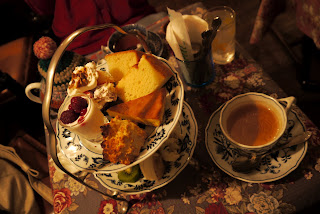English Tea.

Since the 18th century the British have been the largest per capita tea consumers in the world, with each person consuming on average 2.5 kg per year. The popularity of tea occasioned the furtive export of slips to tea plants from China to British India and its commonwealth , beginning in 1840; British interests controlled tea production in the subcontinent. Tea, which was an upper-class drink in Europe, became the infusion of every class in Great Britain in the course of the 18th century and has remained so.
As tea spread throughout the United Kingdom in the 19th century, people started to lay out tea gardens and hold tea dances. The tea gardens lost value after WWII but tea dances are still held today in the United Kingdom.

In Britain tea is usually black tea served with milk (never cream; the cream of a"cream tea" is clotted cream served on scones, usually with strawberry jam, a tradition originating from Devon and Cornwall). Strong tea served with lots of milk and often two teaspoons of sugar, usually in a mug, is commonly referred to as builders tea. Much of the time in the United Kingdom, tea drinking is not the delicate, refined cultural expression that the rest of the world imagines— cup (or commonly a mug) of tea is something drunk often, with some people drinking six or more cups of tea a day. Employers generally allow breaks for tea.

I have been drinking tea since I was very young, and In even remember my mum giving my little sister tea in a drinking bottle when she was a baby. I assume that she did the same for me and all my older sisters and brother when we were young. Now that I am living here in Japan, I am happy to substitute two cups of 'Yorkshire Tea',(My favorite brand of black tea) for two cups of green tea. Green tea is better for your body of so I am told. But there is nothing like a nice 'Cuppa' any time of day.


Comments